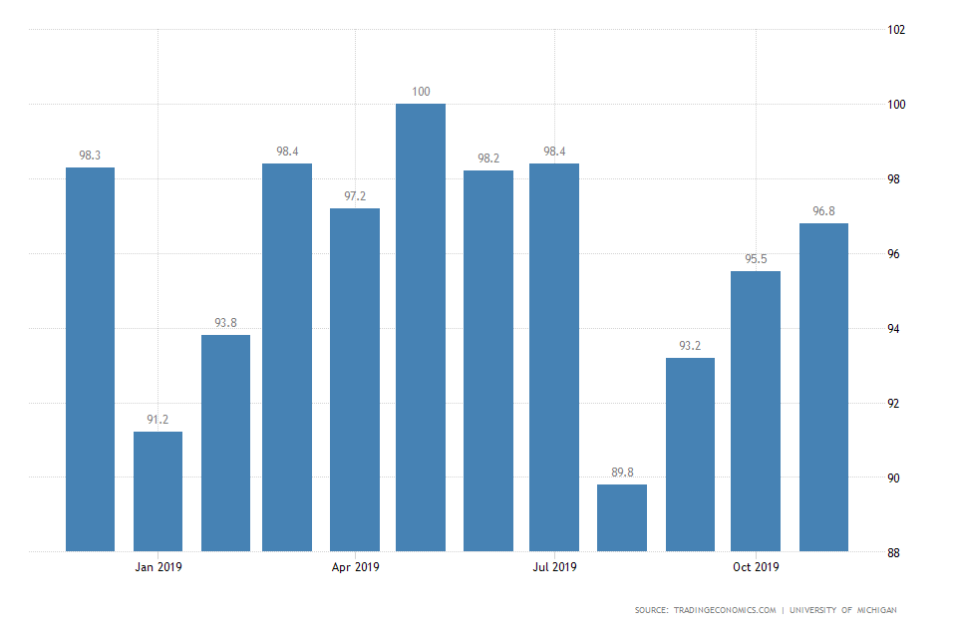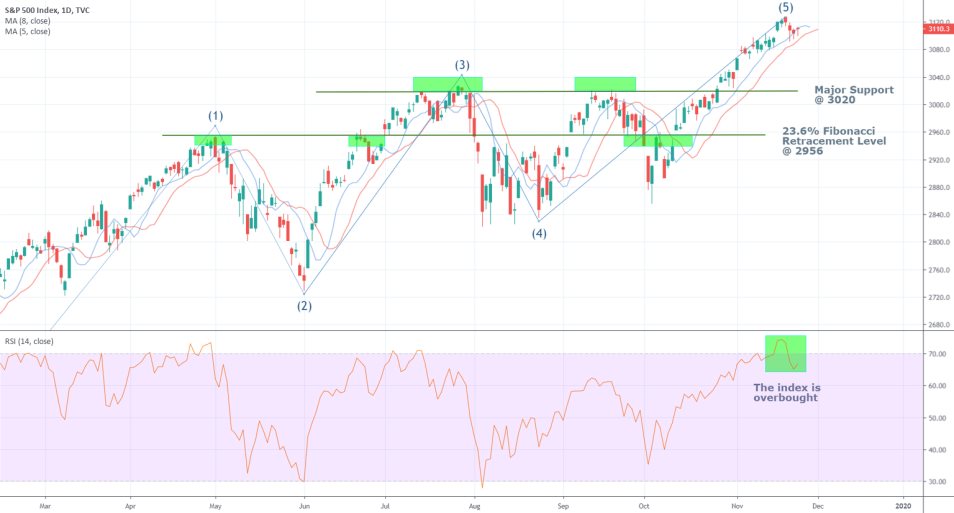
The main economic event for this week is undoubtedly going to be the release of the newest data regarding the consumer confidence index in the United States.
Analysts and market experts are keen on examining the most recent changes (if any) to the index following the observed robust performance of the manufacturing PMI data from last week.
You can read more about the importance of the evidently strengthening US industry for the local growth here.
The recently observed improvement of the economic conditions in the US is expected to stimulate a positive revision in consumer confidence, which, in turn, is an essential indicator for the broader economy’s well-being.
If the value of the index does indeed increase on Tuesday, that would have a predominantly positive impact on US growth and the observed price stability as well.
That is so because, as the consumer sentiment becomes increasingly potent, the overall spending rate is also likely to improve as a consequence, and the final result would be heightened business activity.

The prevailing consumer confidence had surprisingly fallen in August, which marked a tumble of nearly ten index points and the year's biggest disappointment.
Despite the troublesome beginning to Q2, the consumers’ confidence has been steadily improving since then, and the index is currently enjoying a streak of four consecutive months of sustained growth.
If the consensus forecasts are met on Tuesday and the index is shown to have strengthened over the last month, it means that it would get back near to its pre-August value.
Robust consumer sentiment is a harbinger of price stability, which, in turn, drives inflation close to the FED’s symmetric target level at 2 per cent.
It can, therefore, be seen how Tuesday's data would be of crucial importance for the future development of the US monetary policy.
It would also likely be closely scrutinised by market analysts for its overall importance to the stock market and more precisely, whether the booming consumer confidence would support the recent hike in this particular market.
Last week the S&P 500 surged to 3127 basis points, which was an all-time high for the index. However, investors are keen to understand how far could the bullish trend be extended before a price correction occurs.
Currently, the price of the SPX is forming the 5th wave in a classic Elliott wave pattern, and the RSI indicator demonstrates that the price is already becoming overbought.
Thus, a potentially disappointing consumer confidence data on Tuesday could initiate the beginning of such a short-term corrective momentum in the index's price.

Trendsharks Premium
Gold is undergoing a correction, as investors take profits to offset losses from falling stock prices, impacting their margins. However, we anticipate a renewed wave of [...]
The Swiss stock market index is mirroring its global counterparts, such as Germany 40 and US100, experiencing a sharp decline following the announcement of new [...]
We’re analyzing the weekly chart to grasp the broader market trend. Over the past three years, the US30 index has surged by 17,000 points, often resembling a nearly straight [...]
Over the past week, the DAX has experienced a sharp decline, plunging by an astonishing 3,400 points. This downward movement is not isolated, as its international counterparts, such as the UK100 and US100, are also facing significant [...]
EURUSD recently formed a double top at 1.0930, signaling a potential trend reversal, and has since begun a correction. After a 600-pip rally since early March, a pullback at this stage is both expected and healthy. Given these conditions, we are placing a [...]
Since early March, EURJPY has surged nearly 1,000 pips, providing us with several excellent trading opportunities. However, as the rally matures, many early buyers are beginning to take profits, leading to a noticeable slowdown in the uptrend. On Friday, the pair formed a [...]
The AUDJPY currency pair continues to be dominated by bullish momentum, as multiple golden cross patterns reaffirm the strength of the ongoing uptrend. Despite this, we are witnessing a much-needed [...]
The EURAUD currency pair appears to be undergoing a trend reversal, signaling a potential shift in market direction. A notable technical development is the formation of a Death Cross on the chart, a widely recognized bearish indicator that typically suggests a [...]
After securing an impressive 200-pip profit last week, the EURJPY currency pair is now undergoing a southward correction, retracing some of its recent gains. Despite this temporary pullback, the Golden Cross remains intact, reinforcing our view that the overall trend continues to be [...]
The appearance of a Golden Cross in Silver strengthens our analysis that the metal is currently in a strong uptrend, indicating further bullish momentum in the market. This technical pattern, where the short-term moving average crosses above the [...]
This trade presents a considerable level of risk and can be classified as an opportunistic move based on recent price action. The GBPUSD currency pair has experienced a substantial bullish rally, surging by nearly 500 pips in a strong upward movement. However, after this extended period of appreciation, the pair is showing signs of a potential [...]
The anticipated Death Cross on the SMI20 appears to be failing as price finds strong support at the 23% Fibonacci retracement level. After testing this area, the index has shown bullish strength, printing several large green candles, signaling an increase in [...]
A Golden Cross has just appeared on the USDJPY chart, signaling a potential bullish move. This technical pattern occurs when the 20 period moving average crosses above the 60 period moving average, a widely recognized indication of increasing [...]
After 2 months of a down trend, we finally see some indications of price recovery for Oil. The golden cross, a historic buy signal, supports this [...]
For the past month, the German DAX40 has experienced a remarkable 10% surge, reflecting strong bullish momentum. Despite ongoing market volatility and frequent pullbacks, every dip continues to attract fresh buyers, reinforcing the [...]
Oil continues its downward trajectory, despite occasional pullbacks. The overall trend remains bearish, reinforced by multiple Death Cross patterns, a classic sell signal indicating further weakness. Adding to this bearish outlook, the critical [...]
Over the past few days, gold has experienced a sharp decline of more than $100. This downturn can be attributed in part to traders securing profits to manage their margins, which are under strain due to the significant drop in major indices. Currently, gold has fallen below the [...]
The NASDAQ 100 index is showing strong bullish momentum, as evidenced by the formation of a Golden Cross on the chart. This classic buy signal occurs when the short moving average crosses above the long term moving average, suggesting that upward momentum is [...]
The EURAUD currency pair has encountered a significant resistance level, failing to break above the critical 61% Fibonacci retracement level. This suggests that bullish momentum is weakening, reinforcing the case for a potential downward move. Given this technical setup, we favor entering a [...]
The UK100 is experiencing a remarkable rally! Over the past few weeks, the British stock market index has surged nearly 800 points. Each minor dip has attracted more buyers, fueling the bullish momentum. However, since last week, we’ve observed a slight [...]




















